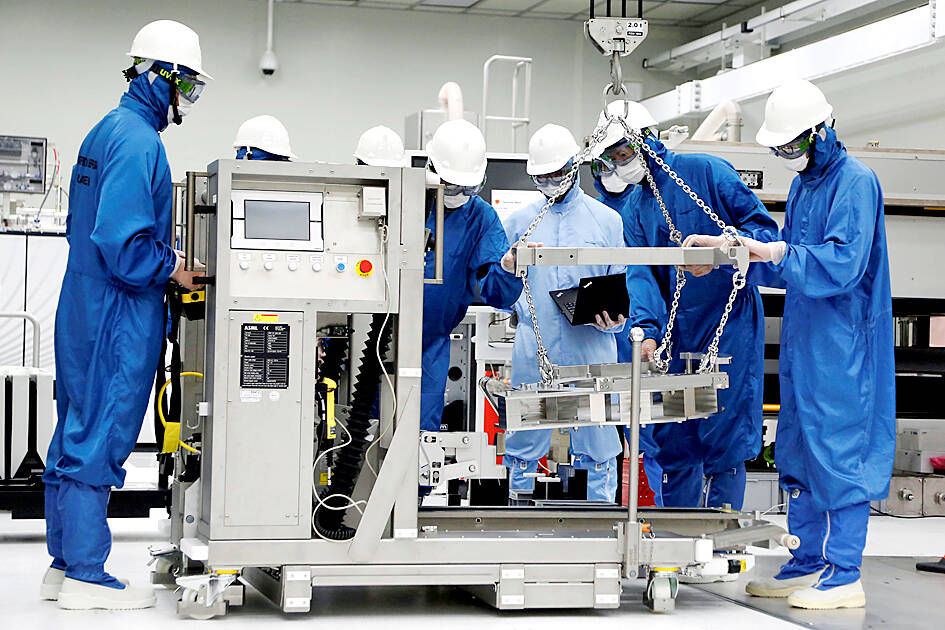The semiconductor industry is facing a talent shortage as the proportion of university students majoring in science, technology, engineering and mathematics (STEM) fields has been declining, a report by the Legislative Yuan said.
Subjects in STEM fields include life science, environmental science, physical chemistry, earth science, mathematics, information and communication technology, engineering, manufacturing and processing, as well as building and construction engineering, the Ministry of Education said.
The proportion of STEM students in colleges and universities, as well as STEM graduates in recent years are far lower than those in 1991, the report prepared by the legislature’s Budget Center said.

Photo: Ann Wang, Reuters
The number of doctoral, master’s and undergraduate students studying in STEM fields dropped by 17.15 percent from 2012 to 2021, and the number of graduates fell by 21.31 percent from 2011 to 2020, the report said.
The number of doctoral students in STEM fields declined by 26.34 percent from 2012 to 2021 and the number of doctorate holders reduced by 23.63 percent from 2011 to 2020, it said.
The proportion of doctoral, master’s and undergraduate students in STEM fields among total students from 2012 to 2021 dropped by 8.9, 1.51 and 1.77 percentage points respectively from 2011 to 2020, it said.
In response to the talent shortage in STEM fields, the ministry has designated semiconductor, artificial intelligence, smart manufacturing, circular economy and finance sectors as “national key fields,” it said.
The ministry approved 10 research institutes in these fields set up by nine universities as of the end of July last year, it said.
National Yang Ming Chiao Tung University, National Cheng Kung University, National Tsing Hua University and National Taiwan University have established semiconductor research institutes, it said.
National Sun Yat-sen University has established semiconductor and finance research institutes; National Taiwan University of Science and Technology has established artificial intelligence and smart manufacturing research institutes; National Chung Hsing University has established a circular economy research institute; and National Taipei University of Technology has established an artificial intelligence research institute, it added.
As these institutes are in preliminary stages, the effectiveness remains to be seen, it said.
Talent shortages in the semiconductor industry have been expanding, it said, citing white papers on talent in the semiconductor industry released by 104 Job Bank.
Research and development engineers are the most important roles businesses that are undergoing transformation seek to fill, it said.
However, a lack of students and graduates, especially at the doctorate level, in the STEM fields could exacerbate the shortages, it added.

Trips for more than 100,000 international and domestic air travelers could be disrupted as China launches a military exercise around Taiwan today, Taiwan’s Civil Aviation Administration (CAA) said yesterday. The exercise could affect nearly 900 flights scheduled to enter the Taipei Flight Information Region (FIR) during the exercise window, it added. A notice issued by the Chinese Civil Aviation Administration showed there would be seven temporary zones around the Taiwan Strait which would be used for live-fire exercises, lasting from 8am to 6pm today. All aircraft are prohibited from entering during exercise, it says. Taipei FIR has 14 international air routes and

Taiwan lacks effective and cost-efficient armaments to intercept rockets, making the planned “T-Dome” interception system necessary, two experts said on Tuesday. The concerns were raised after China’s military fired two waves of rockets during live-fire drills around Taiwan on Tuesday, part of two-day exercises code-named “Justice Mission 2025.” The first wave involved 17 rockets launched at 9am from Pingtan in China’s Fujian Province, according to Lieutenant General Hsieh Jih-sheng (謝日升) of the Office of the Deputy Chief of the General Staff for Intelligence at the Ministry of National Defense. Those rockets landed 70 nautical miles (129.6km) northeast of Keelung without flying over Taiwan,

City buses in Taipei and New Taipei City, as well as the Taipei MRT, would on Saturday begin accepting QR code payments from five electronic payment providers, the Taipei Department of Transportation said yesterday. The new option would allow passengers to use the “transportation QR code” feature from EasyWallet, iPass Money, iCash Pay, Jkopay or PXPay Plus. Passengers should open their preferred electronic payment app, select the “transportation code” — not the regular payment code — unlock it, and scan the code at ticket readers or gates, General Planning Division Director-General Liu Kuo-chu (劉國著) said. People should move through the

The Ministry of National Defense (MND) today released images of the military tracking China’s People's Liberation Army (PLA) movements during the latest round of Chinese drills around Taiwan. The PLA began "Justice Mission 2025" drills today, carrying out live-fire drills, simulated strikes on land and maritime targets, and exercises to blockade the nation's main ports. The exercises are to continue tomorrow, with the PLA announcing sea and air space restrictions for five zones around Taiwan for 10 hours starting from 8:30am. The ministry today released images showing a Chinese J-16 fighter jet tracked by a F-16V Block 20 jet and the